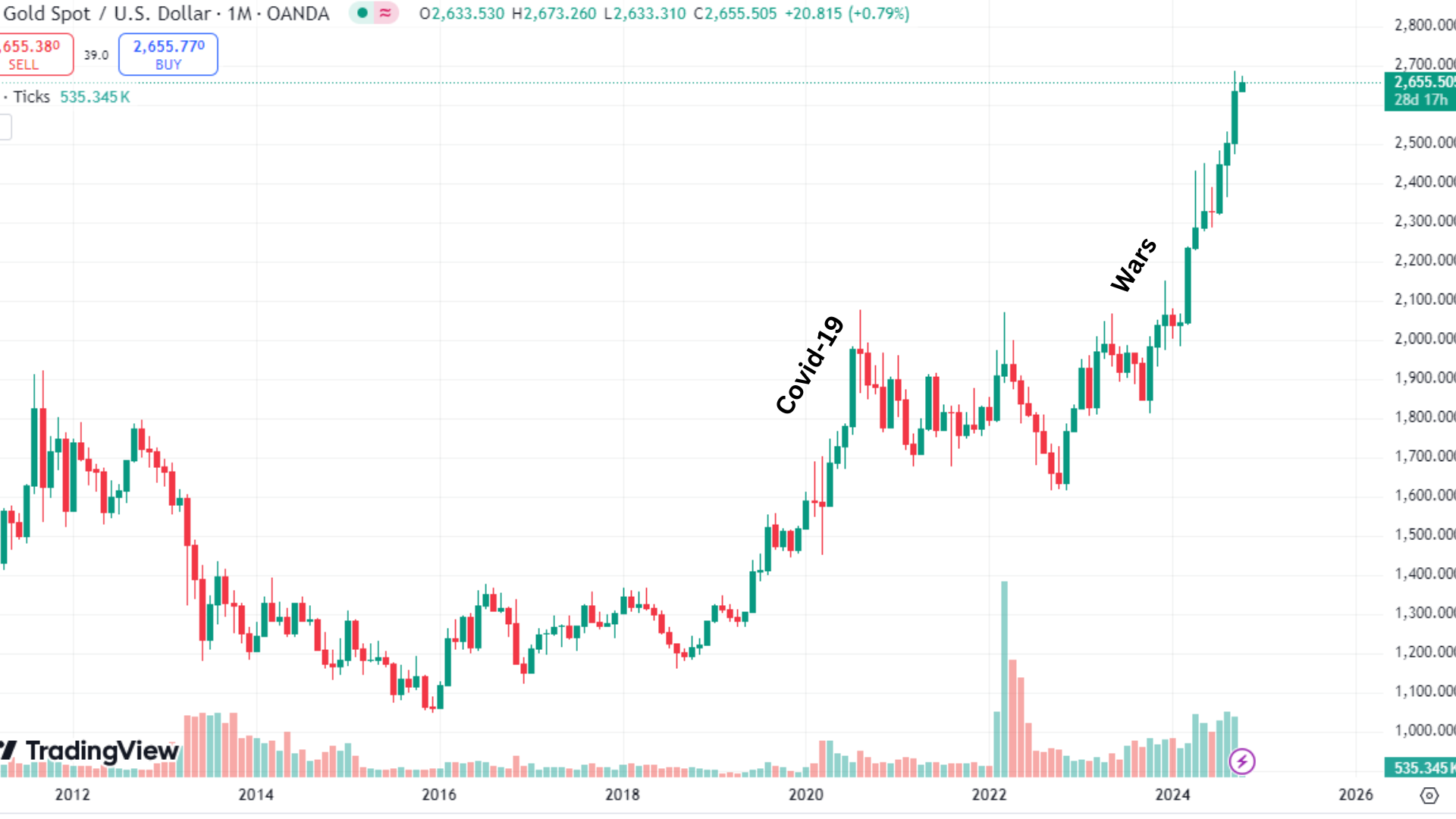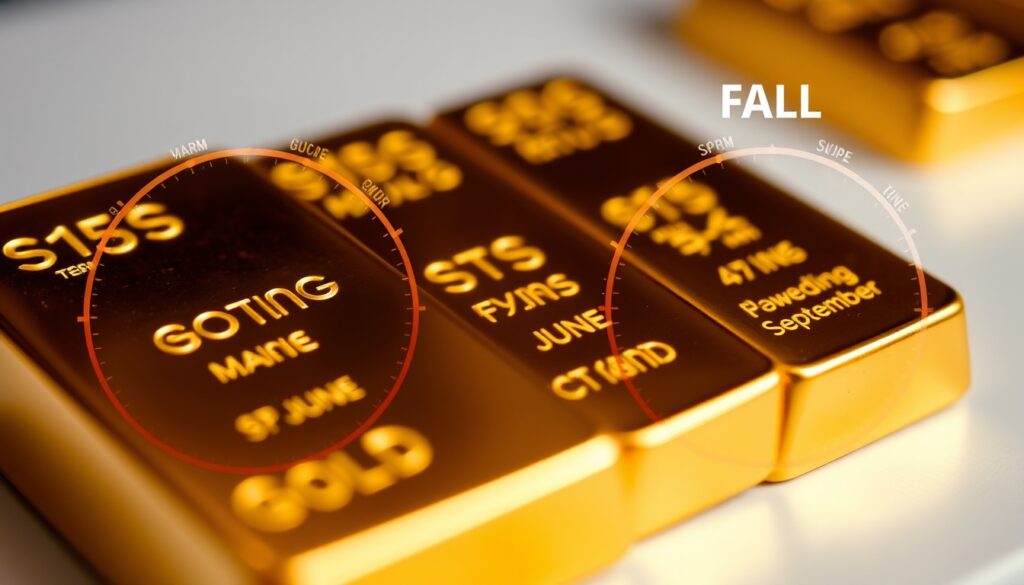Gold has always been cherished, not just for its beauty but for its ability to preserve wealth, especially during times of economic uncertainty. Over the last decade, it has proven to be a reliable asset, drawing attention from both investors and individuals. However, the price of gold doesn’t stay still. It’s influenced by global events, economic policies, and even seasonal factors. Understanding these trends, particularly over the past 10 years, can help you make smarter decisions when buying gold.

Here is a chart comparing gold price trends over the last 10 years, showcasing the average yearly prices as well as the typical low and high seasonal prices:
- The solid line represents the average yearly price of gold.
- The dashed lines indicate the low season prices (typically between March and June) and the high season prices (usually between September and October).
Gold Prices Over the Last 10 Years (2014-2024)
Gold’s performance in the past decade has been shaped by a mix of factors—geopolitical events, global economic conditions, central bank policies, and consumer demand from key markets like India and China. Here’s a breakdown of how prices moved over the last 10 years.
2014–2016: Post-Crisis Recovery and Stability In the years after the 2008 financial crisis, gold prices remained relatively stable. As the global economy slowly recovered, central banks, like the U.S. Federal Reserve, began raising interest rates as economic conditions improved. During this period, gold traded between $1,200 and $1,300 per ounce.
Although prices didn’t skyrocket, gold still provided stability, serving as a hedge against inflation and market volatility.
2017–2019: Trade Wars and Slow Global Growth The U.S.-China trade war dominated headlines and created uncertainty in financial markets, pushing gold prices beyond $1,400 per ounce by mid-2019. Fears of slowing global growth, particularly in Europe and China, further contributed to this price rise.

Events like Brexit and fluctuating oil prices also fueled global volatility, leading more people to turn to gold as a safety net during uncertain times.
2020–2021: The Pandemic Surge The COVID-19 pandemic caused massive economic disruption. Global economies nearly ground to a halt, and gold prices surged to all-time highs. In August 2020, gold surpassed $2,000 per ounce for the first time, reflecting widespread panic and demand for safe-haven assets.
Even though stimulus packages helped mitigate some of the damage, concerns about inflation persisted into 2021, keeping gold prices high. By the end of 2021, prices fluctuated between $1,800 and $2,000 per ounce.
2022–2024: Inflation, Interest Rates, and Geopolitical Tensions As inflation became a global concern in 2022, central banks raised interest rates to combat it. Gold prices wavered between $1,700 and $2,000 per ounce, influenced by inflation trends and geopolitical tensions, such as the Russia-Ukraine conflict.
While rising interest rates led some investors to shift toward assets like bonds, gold remained a key component in portfolios, especially for those seeking stability in a volatile global environment.
Seasonal Trends in Gold Prices
Besides global events, gold prices follow predictable seasonal patterns due to cultural, economic, and market factors. Understanding these seasonal fluctuations can help you time your purchases better.
Highest Prices: September to October Gold usually sees its highest prices between September and October. Several factors contribute to this:
- Festivals and Weddings in India: India is one of the largest consumers of gold, and demand spikes during the festival season (around Diwali and Dussehra) and the wedding season in the latter part of the year, pushing prices up.

- Western Investment Patterns: In Western markets, September is a popular time for increased gold investment as investors review their portfolios after the summer and prepare for potential economic downturns toward the year’s end.
- Monetary Policy Announcements: Central banks often review and adjust monetary policies toward the end of the year, which can influence inflation concerns, driving up gold demand.
- Global Economic Instability: Financial crises or geopolitical events often occur in the latter half of the year, further increasing the demand for gold as a safe asset.

Lowest Prices: March to June Gold prices typically dip between March and June, a period of lower consumer demand and fewer market shocks:
- Post-Holiday Demand Decline: Following the winter holidays and key festivals, demand for gold usually falls, particularly in India after Diwali and the wedding season.
- Spring Economic Stability: Financial markets often stabilize in the spring, reducing the urgency for safe-haven assets like gold, leading to lower prices.
- Tax Filing Season: In Western countries, tax season falls in the spring, which can reduce discretionary spending, including gold investments.
When Is the Best Time to Buy Gold?
The best time to buy gold depends on both market conditions and personal financial goals. Based on the trends of the last 10 years, the most favorable time to purchase gold generally falls during periods when prices dip due to seasonal or economic factors.

Best Time to Buy: March to June If you’re looking to maximize value, the March to June period is usually the best time to buy gold. Prices tend to drop as demand cools down after the festive season, and the financial markets stabilize. Whether you’re buying gold jewelry or investing in bullion, this period offers more cost-effective options.
Best Time to Avoid Buying: September to October Conversely, prices are typically at their highest from September to October, driven by strong demand from cultural events and market volatility. If possible, it’s best to avoid purchasing during this time, as you’ll likely pay a premium.
Other Factors to Consider
While seasonal trends provide a general guideline, other factors can impact when you should buy gold:
- Global Economic Outlook: Economic recessions, wars, or political instability can cause sudden spikes in gold prices. For example, gold prices surged during the COVID-19 pandemic, breaking typical seasonal patterns.
- Interest Rates: Rising interest rates can make other investments, like bonds, more attractive, which can put downward pressure on gold prices.
- Currency Fluctuations: Since gold is often priced in U.S. dollars, fluctuations in currency values can impact the cost of gold, especially for international buyers.
Conclusion
Gold has proven to be a resilient asset over the past decade, maintaining its value even during times of uncertainty. While global events heavily influence its price, seasonal trends also play a significant role. If you’re looking to buy gold, the best time to do so is typically between March and June when prices are lower due to decreased demand. On the other hand, September to October is often the most expensive time to buy, driven by cultural events and market volatility.
By understanding these patterns and staying informed about global trends, you can make more strategic decisions and get the most value for your money when purchasing gold.